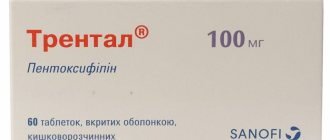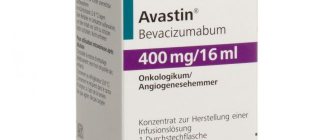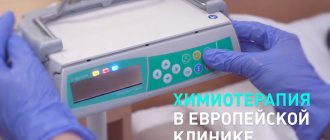Mabthera, 500 mg/50 ml, concentrate for solution for infusion, 50 ml, 1 pc.
Infusion reactions:
chills, weakness, shortness of breath, dyspepsia, nausea, rash, hot flashes, arterial hypotension, arterial hypertension, fever, itching, urticaria, pharyngeal irritation, rhinitis, tachycardia, vomiting, pain, signs of tumor lysis syndrome. In some cases, during the R-CHOP regimen - myocardial infarction, atrial fibrillation and pulmonary edema.
Infections:
respiratory tract infections, most often nasopharyngitis, sinusitis;
bronchitis, pneumonia, lung superinfections, urinary tract infections, sepsis, herpes zoster, septic shock, implant infection, staphylococcal septicemia; severe viral infections (new or reactive) with possible death caused by CMV, Varicella zoster
,
Herpes simplex
, polyomavirus JC (progressive multifocal leukoencephalopathy (PML), hepatitis C virus; very rarely - reactivation of viral hepatitis B.
From the blood and lymphatic system:
leukopenia, neutropenia (4 weeks or more after the last administration of rituximab), thrombocytopenia, anemia, febrile neutropenia; in less than 1% of patients - lymphadenopathy, bleeding disorder. Very rarely - pancytopenia, a transient increase in IgM levels in patients with Waldenström's macroglobulinemia, followed by a return to its original value after 4 months; transient partial aplastic anemia, hemolytic anemia.
From the respiratory system:
rhinitis, mucous discharge from the nose, bronchospasm, cough or increased cough, respiratory disease, shortness of breath, acute respiratory failure, pulmonary infiltrates. Less than 1% of patients have hypoxia, impaired pulmonary function, bronchiolitis obliterans, and asthma.
From the body as a whole, reactions at the injection site:
pharyngeal irritation, angioedema, back pain, chest pain, neck pain, pain in tumor foci, flu-like syndrome, peripheral edema, mucositis, fainting, weight loss, multiple organ failure, rapid tumor lysis syndrome, very rarely - serum disease. Less than 1% of patients experience abdominal enlargement, pain at the injection site, and anaphylactic reactions.
From the gastrointestinal tract:
dyspepsia, nausea, vomiting, diarrhea, lack of appetite, dysphagia, stomatitis, constipation, abdominal pain, perforation of the stomach and/or intestines (possibly fatal).
From the cardiovascular system:
arterial hypotension, arterial hypertension, orthostatic hypotension, tachycardia, bradycardia, arrhythmia (including ventricular and supraventricular tachycardia, atrial fibrillation), unstable angina, vasodilation, venous thrombosis, incl. deep vein thrombosis of the extremities, heart failure, decreased ejection fraction, pulmonary edema, myocardial infarction; very rarely - vasculitis, mainly cutaneous (leukocytoclastic), ischemic cerebrovascular accident.
From the nervous system:
dizziness, headache, paresthesia, hypoesthesia, migraine, very rarely - neuropathy of the cranial nerves, in combination with or without peripheral neuropathy (marked decrease in visual acuity, hearing, damage to other sense organs, facial nerve paralysis) during various periods of therapy - up to several months after completion of MabThera® treatment.
From the mental sphere:
confusion; in less than 1% - nervousness, depression, anxiety, perversion of taste.
From the musculoskeletal system:
myalgia, arthralgia, muscle hypertonicity, muscle spasms, osteoarthritis.
From the endocrine system:
hyperglycemia, decompensation of diabetes mellitus.
From the skin and its appendages:
itching, rash, urticaria, increased sweating at night, sweating, alopecia; very rarely - severe bullous reactions, toxic epidermal necrolysis with a fatal outcome.
From the senses:
lacrimation disorders, conjunctivitis, pain and tinnitus.
From the laboratory parameters:
increased LDH activity, hypocalcemia, hypercholesterolemia, hyperglycemia, bacteremia.
MabThera® monotherapy
Infusion reactions.
Most often develop during the first infusions. The frequency of infusion reactions decreases from 77% (of which 7% are grades 3 and 4) with the 1st infusion to 30% (2% - grades 3 and 4) with the 4th and to 14% (no reactions of grades 3 and 4). 4 degrees of severity) at the 8th infusion.
Infections.
MabThera® causes B cell depletion in 70–80% of patients and a decrease in serum Ig concentration in a small number of patients. Infectious complications (all, regardless of cause) develop in 30.3% of patients: 18.8% - bacterial infections, 10.4% - viral infections, 1.4% - fungal infections, 5.9% - infections without a specified etiology (one patient could have had various infections). Severe infections (grade 3 and 4), including sepsis, were observed in 3.9% of patients: during therapy (1.4%) and in patients during observation without treatment (2.5%).
From the blood system:
severe thrombocytopenia (grades 3 and 4) was observed in 1.7% of patients, severe neutropenia - in 4.2% of patients, and severe anemia (grades 3 and 4) - in 1.1% of patients. A single case of transient aplastic anemia and two cases of hemolytic anemia have also been reported.
From the cardiovascular system:
side effects were noted in 18.8%. The most common are arterial hypo- and hypertension.
MabThera® in combination with chemotherapy according to the CVP regimen (R-CVP)
Grade 3 and 4 infusion reactions (9%):
chills, weakness, shortness of breath, dyspepsia, nausea, rash, hot flashes.
Infections (33% during treatment and 28 days after the end of therapy, compared with 32% of patients receiving CVP alone):
upper respiratory tract infections (12.4%), most often nasopharyngitis, serious infections (4.3%), life-threatening infections were not registered.
From the blood system:
neutropenia of the 3rd and 4th severity (24%), neutropenia of the 4th severity (3.1%). The higher incidence of neutropenia in the R-CVP group did not lead to an increased incidence of infections. Anemia occurred in 0.6% of patients in the R-CVP group and in 1.9% of patients receiving CVP, thrombocytopenia in 1.2% in the R-CVP group and was absent in patients receiving CVP.
Overall incidence of cardiovascular disorders
was similar in patients receiving CVP (5%) and R-CVP (4%).
MabThera® in combination with chemotherapy according to the CHOP regimen (R-CHOP)
Infusion reactions.
Grade 3 and 4 infusion reactions during infusion or within 24 hours after infusion of MabThera® were observed during the first cycle of R-CHOP in 9% of patients. By the 8th cycle of R-CHOP, the incidence of infusion reactions had decreased to less than 1%.
Infections.
The proportion of patients with grade 2–4 infections and/or febrile neutropenia in the R-CHOP group was 55.4%, and in the CHOP group - 51.5%. Cases of febrile neutropenia without concomitant documented infection during therapy were observed in 20.8% of patients receiving R-CHOP and in 15.3% of patients receiving CHOP. The total incidence of grade 2–4 infections in the R-CHOP group was 45.5%, in the CHOP group - 42.3%, while there was no difference in the incidence of systemic bacterial and fungal infections. The incidence of grade 2–4 fungal infections in the R-CHOP group was higher than in the CHOP group (4.5% and 2.6%, respectively); this difference was due to a higher incidence of local candidiasis during therapy. Frequency of herpes infection of 2–4th degree of severity, incl. with eye damage was higher in the R-CHOP group (4.5%) than in the CHOP group (1.5%), in 7 of 9 cases observed in the R-CHOP group, this disease arose during the therapy phase.
Blood system.
After each cycle, grade 3 and 4 leukopenia (88 vs. 79%) and neutropenia (97 vs. 88%) were more common in the R-CHOP group than in the CHOP group, respectively. There was no difference in the incidence of grade 3 and 4 anemia in the two groups (19% in the CHOP group and 14% in the R-CHOP group); There was no difference in the incidence of thrombocytopenia (15% in the CHOP group and 16% in the R-CHOP group). The time to resolution of all hematological disorders was comparable in the two treatment groups.
The cardiovascular system.
The incidence of heart rhythm disturbances of the 3rd and 4th severity, mainly supraventricular arrhythmias (tachycardia, flutter and atrial fibrillation), was higher in the R-CHOP group (6.9%) than in the CHOP group (1.5%) . All arrhythmias developed either in connection with MabThera infusion or were associated with predisposing conditions such as fever, infection, acute myocardial infarction or concomitant diseases of the respiratory and cardiovascular systems. The R-CHOP and CHOP groups did not differ in the incidence of other grade 3 and 4 cardiac adverse events, including heart failure, myocardial disease, and manifestations of coronary artery disease.
Nervous system.
During the first cycle of therapy, 4 patients (2%) in the R-CHOP group with cardiovascular risk factors developed thromboembolic cerebrovascular accidents, in contrast to 1.5% in patients in the CHOP group during the observation period without treatment. There was no difference between groups in the incidence of other thromboembolism.
MabThera® for the treatment of rheumatoid arthritis
Infections.
The probability of infections during MabThera therapy was 0.9 cases per year, the proportion of severe infections, some of which were fatal, did not exceed 0.05 cases per year.
Malignant diseases.
The incidence of malignant diseases after the prescription of MabThera® is 1.5 per 100 patients per year and does not exceed the rates in the population.
Cases of fatal progressive multifocal leukoencephalopathy (PML) have been observed during MabThera therapy in patients with systemic lupus erythematosus (SLE), which is not covered by the prescribing information. A causal relationship with taking MabThera® has not been established; patients had risk factors for developing PML - concomitant diseases, long-term use of immunosuppressive therapy. No cases of PML have been reported in patients with rheumatoid arthritis. If neurological symptoms occur during MabThera® therapy, a neurologist should be consulted and PML should be excluded.
The efficacy and safety of MabThera® in patients with SLE has not been established.
Special categories of patients
High tumor burden
(the diameter of single lesions is more than 10 cm). The frequency of adverse reactions of the 3rd and 4th severity has increased.
Old age (over 65 years):
The frequency and severity of all side effects and grade 3 and 4 side effects are no different from those in younger patients.
Repeat therapy:
the frequency and severity of all side effects does not differ from those during initial therapy.
Mabthera concentrate solution for infusion 500 mg/50 ml 50 ml
Before using MabThera, you should carefully read the instructions and make sure that the dosage form of the drug (“concentrate for solution for infusion” or “solution for subcutaneous administration”) and dosage correspond to those prescribed to the patient. MabThera should only be administered when the necessary conditions for resuscitation are available under the close supervision of an oncologist, hematologist or rheumatologist. MabThera in the dosage form “concentrate for solution for infusion” is not intended for subcutaneous administration! MabThera is administered only intravenously through a separate catheter! It is impossible to administer the drug intravenously as a bolus or bolus! Rules for preparing and storing the solution. The required amount of the drug is taken under aseptic conditions and diluted to the calculated concentration (1-4 mg/ml) in an infusion bottle (bag) with 0.9% sodium chloride solution for infusion or 5% dextrose solution (solutions must be sterile and pyrogen-free). To mix, carefully turn the bottle (package) over to avoid foaming. Before administration, it is necessary to inspect the solution for the absence of foreign impurities or discoloration. The doctor is responsible for the preparation, conditions and storage time of the prepared solution before its use. Since MabThera does not contain preservatives, the prepared solution must be used immediately. The prepared infusion solution of MabThera is physically and chemically stable for 12 hours at room temperature or for no more than 24 hours at a temperature of 2 to 8°C. Standard dosage regimen. Low-grade or follicular non-Hodgkin's lymphoma. Before each use of MabThera, premedication (analgesic/antipyretic, e.g. paracetamol; antihistamine, e.g. diphenhydramine) must be given. If MabThera is not used in combination with chemotherapy containing glucocorticosteroids, glucocorticosteroids are also included in the premedication. Dose adjustment during therapy. It is not recommended to reduce the dose of MabThera. If MabThera is administered in combination with chemotherapy, dose reduction of chemotherapy drugs is carried out according to standard recommendations. Initial therapy: - monotherapy for adult patients: 375 mg/m2 once a week for 4 weeks; - in combination with chemotherapy according to any regimen: 375 mg/m2 on the first day of the chemotherapy cycle after intravenous administration of a glucocorticosteroid as a component of therapy, for: 8 cycles (cycle: 21 days) with the R-CVP regimen (rituximab, cyclophosphamide, vincristine, prednisolone); 8 cycles (cycle: 28 days) with the R-MCP regimen (rituximab, mitoxantrone, chlorambucil, prednisolone); 8 cycles (cycle: 21 days) with the R-CHOP regimen (rituximab, cyclophosphamide, doxorubicin, vincristine, prednisolone); if complete remission is achieved after 4 cycles, it is possible to limit yourself to 6 cycles; 6 cycles (cycle: 21 days) with the R-CHVP-Interferon regimen (rituximab, cyclophosphamide, doxorubicin, teniposide, prednisolone + interferon). Repeated use in case of relapse (in patients who responded to the first course of therapy): 375 mg/m2 once a week for 4 weeks. Maintenance therapy (after response to induction therapy): in previously untreated patients: 375 mg/m2 once every 2 months, not more than 2 years (12 infusions). If signs of disease progression appear, MabThera therapy should be discontinued; for recurrent or chemoresistant lymphoma: 375 mg/m2 once every 3 months, no more than 2 years. If signs of disease progression appear, MabThera therapy should be discontinued. The recommended initial rate of the first infusion is 50 mg/h, subsequently it can be increased by 50 mg/h every 30 minutes, leading to a maximum rate of 400 mg/h. Subsequent infusions can be started at a rate of 100 mg/hour and increased by 100 mg/hour every 30 minutes to a maximum rate of 400 mg/hour. Diffuse large B-cell non-Hodgkin lymphoma. Before each use of MabThera, premedication (analgesic/antipyretic, e.g. paracetamol; antihistamine, e.g. diphenhydramine) must be given. If MabThera is not used in combination with chemotherapy containing glucocorticosteroids, glucocorticosteroids are also included in the premedication. Dose adjustment during therapy. It is not recommended to reduce the dose of MabThera. If MabThera is administered in combination with chemotherapy, dose reduction of chemotherapy drugs is carried out according to standard recommendations. In combination with chemotherapy according to the CHOP regimen: 375 mg/m2 on the first day of each chemotherapy cycle after intravenous administration of a glucocorticosteroid, 8 cycles. The other components of the CHOP regimen (cyclophosphamide, doxorubicin and vincristine) are administered after MabThera is prescribed. The recommended initial rate of the first infusion is 50 mg/h, subsequently it can be increased by 50 mg/h every 30 minutes, leading to a maximum rate of 400 mg/h. Subsequent infusions can be started at a rate of 100 mg/hour and increased by 100 mg/hour every 30 minutes to a maximum rate of 400 mg/hour. Chronic lymphocytic leukemia. Before each use of MabThera, premedication (analgesic/antipyretic, eg paracetamol; antihistamine, eg diphenhydramine) should be given. If MabThera is not used in combination with chemotherapy containing glucocorticosteroids, glucocorticosteroids are also included in the premedication. To reduce the risk of tumor lysis syndrome, prophylactic provision of adequate hydration and administration of uricostatics 48 hours before the start of therapy is recommended. In patients with chronic lymphocytic leukemia and a lymphocyte count >25 thousand/μL, intravenous prednisone/prednisolone 100 mg is recommended 1 hour before MabThera administration to reduce the frequency and severity of acute infusion reactions and/or cytokine release syndrome. Dose adjustment during therapy. It is not recommended to reduce the dose of MabThera. If MabThera is administered in combination with chemotherapy, dose reduction of chemotherapy drugs is carried out according to standard recommendations. In combination with chemotherapy (in patients who have not previously received standard therapy and with relapsed/chemoresistant lymphocytic leukemia): 375 mg/m2 on the first day of the first cycle, then 500 mg/m2 on the first day of each subsequent cycle, 6 cycles. Chemotherapy is given after MabThera is administered. The recommended initial rate of the first infusion is 50 mg/h, subsequently it can be increased by 50 mg/h every 30 minutes, leading to a maximum rate of 400 mg/h. Subsequent infusions can be started at a rate of 100 mg/hour and increased by 100 mg/hour every 30 minutes to a maximum rate of 400 mg/hour. Rheumatoid arthritis. Premedication (analgesic/antipyretic, eg paracetamol; antihistamine, eg diphenhydramine) must be given before each MabThera infusion. In addition, premedication with glucocorticosteroids should be performed to reduce the frequency and severity of infusion reactions. Patients should receive 100 mg methylprednisolone IV 30 minutes before each MabThera infusion. Initial therapy: 1000 mg IV drip, slowly, once every 2 weeks, course - 2 infusions. Repeated use: the need for repeated courses of therapy is recommended to be assessed 24 weeks after the previous course. Repeated use is carried out if there is residual disease activity or if disease activity increases to more than 2.6 according to DAS28-ESR (index of disease activity for 28 joints and erythrocyte sedimentation rate). Repeated courses can be prescribed no earlier than 16 weeks after the previous course. Recommended dosage regimen for repeated use: 1000 mg once every 2 weeks, course – 2 infusions. The recommended initial rate of the first infusion is 50 mg/h, subsequently it can be increased by 50 mg/h every 30 minutes, leading to a maximum rate of 400 mg/h. Infusion time is 4 hours 15 minutes. Subsequent infusions can be started at a rate of 100 mg/hour and increased by 100 mg/hour every 30 minutes to a maximum rate of 400 mg/hour. Infusion time is 3 hours 15 minutes. An alternative regimen for increasing the rate of subsequent infusions in patients with rheumatoid arthritis. If the patient has not previously developed a serious infusion reaction when administered MabThera, an alternative time for subsequent infusions of MabThera diluted to a concentration of 4 mg/ml (250 ml solution) is 120 minutes: during the first 30 minutes the drug is administered at a rate of 250 mg/h, the next 90 minutes - at a rate of 600 mg/h. If well tolerated, infusions lasting 120 minutes can also be recommended for subsequent infusions and courses. An alternative regimen to increase the rate of subsequent infusions should not be used in patients with clinically significant cardiovascular disease, including arrhythmias, or a history of serious infusion reactions to biological agents, including rituximab. Granulomatosis with polyangiitis (Wegener's granulomatosis) and microscopic polyangiitis. Premedication (analgesic/antipyretic, eg paracetamol; antihistamine, eg diphenhydramine) must be given before each MabThera infusion. Recommended Dosing: Corticosteroid therapy is recommended to begin within 2 weeks before the first MabThera infusion or immediately on the day of the first MabThera infusion: methylprednisolone (IV) at a dose of 1000 mg/day for 1 to 3 days, then oral prednisolone at a dose of 1 mg/kg/day (but not more than 80 mg/day) with a gradual reduction in the dose of the latter until complete withdrawal (the rate of dose reduction is determined by the specific clinical situation). Oral corticosteroid therapy may be continued during and after discontinuation of MabThera; Mabthera – 375 mg/m2 once a week for 4 weeks. The recommended initial rate of the first infusion is 50 mg/h, subsequently it can be increased by 50 mg/h every 30 minutes, leading to a maximum rate of 400 mg/h. Subsequent infusions can be started at a rate of 100 mg/hour and increased by 100 mg/hour every 30 minutes to a maximum rate of 400 mg/hour. During and after completion of MabThera therapy in patients with granulomatosis with polyangiitis (Wegener's granulomatosis) and microscopic polyangiitis, prophylaxis against Pneumocystis jiroveci is recommended.




